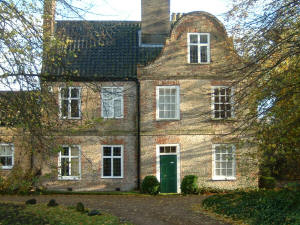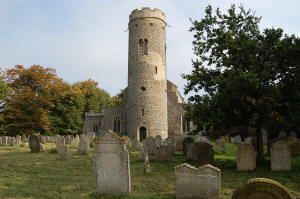Forncett St. Peter
|
| Forncett St. Peter is a small village in the Upper
Tas valley which lies a few miles west of Long Stratton.
In 1788 Dorothy Wordsworth moved to the Rectory in
Forncett St. Peter when her neice married the Rev.
William Cookson. The Rectory, a fine Georgian building,
stands next to St. Peter's Church.

Forncett St Peter
Rectory

Forncett Church
Dorothy stayed in the village for 6 years and spent
her time doing parish work and going on walks -
particularly in the water meadows by the
River Tas.
At this time, her brother William Wordsworth was
still an undergraduate at Cambridge University and
she wrote to him frequently. Both of their parents had
died and so brother and sister had developed a close
relationship - one which would last through-out their
lives. Wordsworth often drew upon his sister's thoughts
and observations to furnish his poems - especially when
they both moved to the Lake District.
William visited Dorothy at Forncett in the summer of
1789 and again during the
Christmas period of 1790. However, Rev. Cookson
disapproved of Wordsworth's recent love affair with
Marie Anne Vallon (who he had met in France) and the
fact that it had produced a child born out of wedlock;
William never visited again.
William went on a number of walks while staying at
Forncett and was inspired to write the following untitled sonnet:
|
Sweet was the walk
along the narrow lane
At noon, the bank and hedge-rows all the way
Shagged with wild pale green tufts of fragrant hay,
Caught by the hawthorns from the loaded wain,
Which Age with many a slow stoop strove to gain;
And childhood, seeming still most busy, took
His little rake; with cunning side-long look,
Sauntering to pluck the strawberries wild, unseen.
Now, too, on melancholy's idle dreams
Musing, the lone spot with my soul agrees,
Quiet and dark; for through the thick wove trees
Scarce peeps the curious star till solemn gleams
The clouded moon, and calls me forth to stray
Thro' tall, green, silent woods and ruins gray. |
|

Dorothy Wordsworth
(Detail of an oil painting by
Samuel Crosthwaite, 1835) In The
Ballad of Dorothy Wordsworth - Frances Wilson
describes both the rectory and the church as follows:
|
|
'The red and black bricked rectory of Forncett St Peter,
halfway between the towns of Norwich and Diss, is found
at the end of a long and tree-lined gravel path. Set in
an isolated spot above a small rise in the River Tas, it
is a handsome, comfortable Queen Anne house complete
with a Dutch gable. Next to it lies the church of St
Peter and St Paul, with it's spacious graveyard, it's
rooks, and cowslips and striking Anglo-Saxon round tower
built in flint. The light sandy loam of Forncett St
Peter is markedly different from the rocky terrains that
Dorothy had been used to in Yorkshire and Cumberland.
Entering East Anglia even from London, you feel the
immediate strangeness of the place, the way in which the
flatness of the land exaggerates perspective and
elongates the horizon, allowing long but disquietingly
uneventful views, transforming the scale of things so
that the spires and trees are given a squat appearance.
It is a curious thought that it was here, under the
ever-expanding East Anglian skies that Dorothy and
William both Northern to the core, should nurture their
future relationship.' |
Nearly two hundred years later another great poet would
visit the village. This time it was Philip Larkin who was staying,
at the time, with his friend and editor
Anthony Thwaite at nearby Low
Tharston. In his diary Larkin records the atmosphere
of the location: 'I shall remember Forncett for a long
time: the roaring trees, the exultant rooks, the
flowering graveyard.'
|
|

